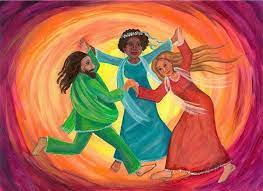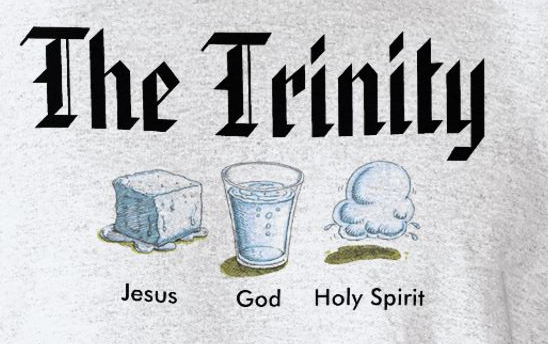
See previous post. This is what I said.
At the Parliament of the World’s Religions in Salt Lake City 2015, I was scheduled to present a workshop on Monday afternoon. On Sunday evening, I discovered that my workshop had been deleted from the Parliament app. Panicking, I ran down to the Parliament office in the Salt Palace, but it was Sunday evening; no one was there, except for one young volunteer. I explained the problem and he started making calls. Finally, he said he’d left a message for someone who could help, but we needed to wait for a callback. So, we waited and talked. The young man explained that he was a Hindu, a religion major at a local college. They were studying Christianity that semester and he had a question? “Could you explain the Trinity?”
It’s not uncommon for the Trinity to come up in interfaith settings.
And tonight I’m supposed to explain it to you – in nine minutes!
Simplest definition: Trinity, in Christian doctrine, is the unity of Father, Son, and Holy Spirit as three persons in one Godhead. However, it’s not that simple. The doctrine of the Trinity isn’t in the Bible, although some Christians do find hints of trinitarian language. It didn’t become a doctrine until the 4th century. Not all Christian groups are trinitarian, and even for some that are, it’s become a bit of a conundrum, as we strive to place our relationship with the Divine above belief in doctrines and dogma.

It certainly is a reminder of our history, of what was important to the early church fathers (and they were all men), as they tried to make sense of the relationship of Jesus to God and how the Holy Spirit fit into the picture. Without going into detail, they used Greek philosophy to explain how there could be just one God. That’s where you get language like Jesus Christ “being of one substance with the Father” – pure Aristotle.
But it’s important to remember that before the 4th century, there were other ways of understanding Trinity. But Emperor Constantine wanted a unified message on Christian beliefs. And so it was done. And all who disagreed with the winners were condemned as heretics.
But times have changed. Adherence to doctrines and dogma has become more a source of division than unity. And once again, other understandings of Trinity are being remembered. Instead of relying only on the scholastic theology of the 11th-13th centuries that elevated knowledge, understanding, and rationality that has dominated our approach to the Trinity, we’re also rediscovering the spirituality of Christian mystics. In other words, engaging both left and right sides brains.

For example, the Cappadocian Fathers of 4th century Turkey said: “Whatever is going on in God is a flow, a radical relatedness, a perfect communion between Three — a circle dance of love. And God is not just a dancer; God is the dance itself.”
Other Greek Fathers also depicted Trinity as a Round Dance, calling it “an event that has continued for 6000 years, and 6 X 6000, and beyond the time when humans first knew time. An infinite current of love streams without ceasing.”
In our day, Father Richard Rohr, author of The Divine Dance picks up the theme: “Trinity is the very nature of God, and this God is a circle dance, a centrifugal force flowing outward, and then drawing all things into the dance centripetally.”
Medieval Christian mystics, such as Hildegard of Bingen, Meister Eckhart, and Julian of Norwich also wrote out of their experience of Trinity.

For example, Julian who spent years reflecting and writing on visions she’d had when she was 30 years old, really delves into the 3-ness of it all. Probably the most famous of her visions was this one, from this comes the portrayal we often see of her holding a hazelnut. She wrote:
“In this God showed me a little thing, no bigger than a hazel nut, lying in the palm of my hand. In this little thing I saw three properties. The first is that God made it. The second that God loves it. And the third, that God keeps it. But what is this to me? Truly, the Creator, the Keeper, the Lover. For until I am substantially “oned” to God, I may never have full rest nor true bliss. That is to say, until I be so fastened to God that there is nothing that is made between my God and me.”
Now you still might be thinking that we’re trying to force God into a 3-part box. Why hang onto Trinity at all? In a stunning recent work called The Holy Trinity and the Law of Three, Cynthia Bourgeault, busts open our silly attempts at defining God, at the same time reclaiming Trinity for a new spiritual age. She suggests that the principle of three is actually the operating principle of the universe (present in many religions) which undercuts all of our dualistic thinking (light/dark; heaven/earth; human/divine; male/female, etc.) that holds us back from being fully human.
She’s actually echoing what Carl Jung discovered over 100 years ago: “Triads of gods appear very early, at the primitive level. Arrangement in triads is an archetype in the history of religion, which in all probability formed the basis of the Christian Trinity.”
So while we’ve traditionally explained the development of the doctrine of the Trinity as the need to give divine status to Jesus and the Holy Spirit while remaining monotheistic, it might be the other way round. Our unconscious disposition was already trinitarian, which then required a theological explanation. Three is often considered to be the perfect number, the unifier of dualities. And it does appear, not only in Christianity, but across cultures, religions, and time.
Richard Rohr: “Trinitarian theology was almost made to order to humiliate the logical mind. If actually encountered and meditated on, God as trinity breaks down the binary system of the mind. It makes either-or thinking totally useless. Perhaps, in addition to everything else, trinity is blessing, to make us patient before Mystery and to humble our dualistic minds.”
So, if we go back before all the controversies of early Christianity and before our modern attempts to explain Trinity with shamrocks, triangles, interlocking rings, and science project displays of water, ice, and steam, we find that our ancient ancestors understood the triune nature of existence on the deepest subconscious level, which then translated into symbols and archetypes found in our origin stories, myths and even fairy tales, like The Three Little Pigs and Goldilocks and the Three Bears and children’s songs like Three Blind Mice.
And this is how we can find our place within the story. What the mystics have described is the communal nature of the Divine, the inherent relationality of the Trinity. The Creator, the Keeper and the Lover are not self-contained entities in a pantheon of gods. Rather, the Trinity is a dance of Love, with us dancing in the midst of the circle as well. It is a dance of relationship, of communion and of community.
As we become more adept at using our right brains to re-imagine what God is like, we will see Trinity (this number three), not as a literal, limiting number, but as a process of union with the completeness and perfection of All That Is whether you call that: Father/Son/Holy Spirit, Creator/Redeemer/Sanctifier, Creator/Creating/Creation, or (as St. Augustine suggested) Lover/ Beloved/ Love Itself.





